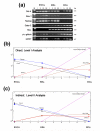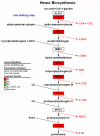GeneChip analysis of human embryonic stem cell differentiation into hemangioblasts: an in silico dissection of mixed phenotypes
- PMID: 17999768
- PMCID: PMC2258184
- DOI: 10.1186/gb-2007-8-11-r240
GeneChip analysis of human embryonic stem cell differentiation into hemangioblasts: an in silico dissection of mixed phenotypes
Abstract
Background: Microarrays are being used to understand human embryonic stem cell (hESC) differentiation. Most differentiation protocols use a multi-stage approach that induces commitment along a particular lineage. Therefore, each stage represents a more mature and less heterogeneous phenotype. Thus, characterizing the heterogeneous progenitor populations upon differentiation are of increasing importance. Here we describe a novel method of data analysis using a recently developed differentiation protocol involving the formation of functional hemangioblasts from hESCs. Blast cells are multipotent and can differentiate into multiple lineages of hematopoeitic cells (erythroid, granulocyte and macrophage), endothelial and smooth muscle cells.
Results: Large-scale transcriptional analysis was performed at distinct time points of hESC differentiation (undifferentiated hESCs, embryoid bodies, and blast cells, the last of which generates both hematopoietic and endothelial progenies). Identifying genes enriched in blast cells relative to hESCs revealed a genetic signature indicative of erythroblasts, suggesting that erythroblasts are the predominant cell type in the blast cell population. Because of the heterogeneity of blast cells, numerous comparisons were made to publicly available data sets in silico, some of which blast cells are capable of differentiating into, to assess and characterize the blast cell population. Biologically relevant comparisons masked particular genetic signatures within the heterogeneous population and identified genetic signatures indicating the presence of endothelia, cardiomyocytes, and hematopoietic lineages in the blast cell population.
Conclusion: The significance of this microarray study is in its ability to assess and identify cellular populations within a heterogeneous population through biologically relevant in silico comparisons of publicly available data sets. In conclusion, multiple in silico comparisons were necessary to characterize tissue-specific genetic signatures within a heterogeneous hemangioblast population.
Figures






Similar articles
-
Development of the hemangioblast defines the onset of hematopoiesis in human ES cell differentiation cultures.Blood. 2007 Apr 1;109(7):2679-87. doi: 10.1182/blood-2006-09-047704. Blood. 2007. PMID: 17148580 Free PMC article.
-
3D microcarrier system for efficient differentiation of human pluripotent stem cells into hematopoietic cells without feeders and serum [corrected].Regen Med. 2013 Jul;8(4):413-24. doi: 10.2217/rme.13.36. Regen Med. 2013. PMID: 23826696
-
Mouse lysocardiolipin acyltransferase controls the development of hematopoietic and endothelial lineages during in vitro embryonic stem-cell differentiation.Blood. 2007 Nov 15;110(10):3601-9. doi: 10.1182/blood-2007-04-086827. Epub 2007 Aug 3. Blood. 2007. PMID: 17675553 Free PMC article.
-
Dissecting hematopoietic differentiation using the embryonic stem cell differentiation model.Int J Dev Biol. 2010;54(6-7):991-1002. doi: 10.1387/ijdb.103065th. Int J Dev Biol. 2010. PMID: 20711977 Review.
-
A review of gene expression profiling of human embryonic stem cell lines and their differentiated progeny.Curr Stem Cell Res Ther. 2009 May;4(2):98-106. doi: 10.2174/157488809788167409. Curr Stem Cell Res Ther. 2009. PMID: 19442194 Review.
Cited by
-
Temporal changes in Hox gene expression accompany endothelial cell differentiation of embryonic stem cells.Cell Adh Migr. 2011 Mar-Apr;5(2):133-41. doi: 10.4161/cam.5.2.14373. Epub 2011 Mar 1. Cell Adh Migr. 2011. PMID: 21200152 Free PMC article.
-
Sources of stem cells for regenerative medicine.Stem Cell Rev. 2008 Spring;4(1):3-11. doi: 10.1007/s12015-008-9010-8. Stem Cell Rev. 2008. PMID: 18286392 Review.
-
Discovery of consensus gene signature and intermodular connectivity defining self-renewal of human embryonic stem cells.Stem Cells. 2014 Jun;32(6):1468-79. doi: 10.1002/stem.1675. Stem Cells. 2014. PMID: 24519983 Free PMC article.
-
Gene expression analysis of embryonic stem cells expressing VE-cadherin (CD144) during endothelial differentiation.BMC Genomics. 2008 May 22;9:240. doi: 10.1186/1471-2164-9-240. BMC Genomics. 2008. PMID: 18498633 Free PMC article.
-
MicroRNA and gene expression patterns in the differentiation of human embryonic stem cells.J Transl Med. 2009 Mar 23;7:20. doi: 10.1186/1479-5876-7-20. J Transl Med. 2009. PMID: 19309508 Free PMC article.
References
-
- Wang L, Li L, Shojaei F, Levac K, Cerdan C, Menendez P, Martin T, Rouleau A, Bhatia Ml. Endothelial and hematopoietic cell fate of human embryonic stem cells originates from primitive endothelium with hemangioblastic properties. Immunity. 2004;21:31–41. doi: 10.1016/j.immuni.2004.06.006. - DOI - PubMed
MeSH terms
Substances
LinkOut - more resources
Full Text Sources
Other Literature Sources
Molecular Biology Databases
Research Materials

